Impact of Environmental Changes on UNESCO World Heritage Sites
21 Pages7275 Words1 Views
Added on 2022-12-27
About This Document
This report examines the impact of environmental changes on UNESCO World Heritage Sites and discusses intervention and mitigation strategies at different levels. It also references protocols, agreements, and documents related to the protection and conservation of these sites.
Impact of Environmental Changes on UNESCO World Heritage Sites
Added on 2022-12-27
ShareRelated Documents
CONSTRUCTION
PROJECT
MANAGEMENT
PROJECT
MANAGEMENT

Table of Contents
INTRODUCTION...........................................................................................................................3
TASK 1............................................................................................................................................3
Cause and effect of environmental changes on UNESCO World heritage sites....................3
Intervention and mitigation at local, national and international level....................................5
Appropriate reference to protocols, International agreements, organisations documents and
relevant legislation and its application to the World Heritage Site under investigation........6
Consider three world heritage sites that may be at risk of losing their status, due to
environmental degradation through inappropriate development, human intervention or
consumption or natural deterioration of fabric and material..................................................9
TASK 2..........................................................................................................................................11
Discuss key issues associated with the safety of dams.........................................................11
Discuss the importance of developing on-site and off-site emergency preparedness and
response plan in the case of emergency or a dam failure.....................................................12
Elements of emergency action plan......................................................................................15
Impacts of failure of a dam on safety of the people living downstream, damages to properties
and infrastructure and the environment................................................................................16
CONCLUSION..............................................................................................................................17
REFERENCES..............................................................................................................................19
INTRODUCTION...........................................................................................................................3
TASK 1............................................................................................................................................3
Cause and effect of environmental changes on UNESCO World heritage sites....................3
Intervention and mitigation at local, national and international level....................................5
Appropriate reference to protocols, International agreements, organisations documents and
relevant legislation and its application to the World Heritage Site under investigation........6
Consider three world heritage sites that may be at risk of losing their status, due to
environmental degradation through inappropriate development, human intervention or
consumption or natural deterioration of fabric and material..................................................9
TASK 2..........................................................................................................................................11
Discuss key issues associated with the safety of dams.........................................................11
Discuss the importance of developing on-site and off-site emergency preparedness and
response plan in the case of emergency or a dam failure.....................................................12
Elements of emergency action plan......................................................................................15
Impacts of failure of a dam on safety of the people living downstream, damages to properties
and infrastructure and the environment................................................................................16
CONCLUSION..............................................................................................................................17
REFERENCES..............................................................................................................................19
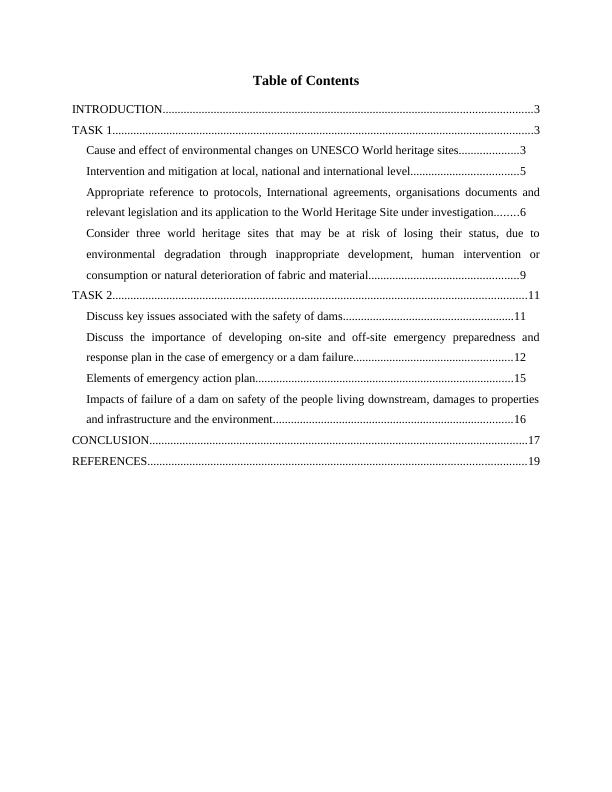
INTRODUCTION
This report revolves around impact of environmental issues on world heritage sties and
impact of climate change on these heritage at local, national and international level.
Environmental issues such as Global warming, ozone depletion etc. are factors which have
affected climate across the globe. Climate change become major threat for several cultural sites
and natural world heritage site. This report focuses on impact of climate on world heritage sites
and how climate change can also increase the other effects such as urbanization, natural
resources, pollution etc. There are more than 1000 world heritage sites in 163 countries as some
of them are considered as important tourist destinations across the globe. Tourism have also
affected world heritage site in negative manner, tourism which is considered beneficial for
economic development of economy and help in bringing financial stability to economy but there
are some negative effects of tourism such as tourism development and excessive visitors.
Climate change have affected existing issues which are affecting world heritage sites and factors
such as sea-level rise, higher temperatures, shift in habitat and different weather conditions such
as storms, floods and droughts etc. have affected world heritage site and these factors are
affecting attributes of world heritage sites which is considered as serious issue.
This report focus on identifying and resolving environmental issues which are affecting
world heritage sites which includes cultural heritage site are vulnerable to climate change and
tourism sector also is considered vulnerable to climate change (Ahmed, 2018). Threats to
cultural heritage site includes extreme weather which increases costs related to insurance and
concerns related with safety and damages to premises of heritage site. This report focuses on
issue related with disruption to natural and cultural heritage site in world due to climate change
and it can also affect the tourism sector and reduce the attractiveness of heritage sites.
TASK 1
Cause and effect of environmental changes on UNESCO World heritage sites
Environmental changes have affected heritage sites all across the globe and UNESCO as
a body is focusing on maintaining values within those properties and help in maintaining heritage
properties for future generation. World heritage sites which should be preserved and maintained
in order to promote tourism sector (Burger and Zulch, 2018). Environment changes have made
its impact on world heritage site as impact of change in temperature, rise in sea level, greenhouse
This report revolves around impact of environmental issues on world heritage sties and
impact of climate change on these heritage at local, national and international level.
Environmental issues such as Global warming, ozone depletion etc. are factors which have
affected climate across the globe. Climate change become major threat for several cultural sites
and natural world heritage site. This report focuses on impact of climate on world heritage sites
and how climate change can also increase the other effects such as urbanization, natural
resources, pollution etc. There are more than 1000 world heritage sites in 163 countries as some
of them are considered as important tourist destinations across the globe. Tourism have also
affected world heritage site in negative manner, tourism which is considered beneficial for
economic development of economy and help in bringing financial stability to economy but there
are some negative effects of tourism such as tourism development and excessive visitors.
Climate change have affected existing issues which are affecting world heritage sites and factors
such as sea-level rise, higher temperatures, shift in habitat and different weather conditions such
as storms, floods and droughts etc. have affected world heritage site and these factors are
affecting attributes of world heritage sites which is considered as serious issue.
This report focus on identifying and resolving environmental issues which are affecting
world heritage sites which includes cultural heritage site are vulnerable to climate change and
tourism sector also is considered vulnerable to climate change (Ahmed, 2018). Threats to
cultural heritage site includes extreme weather which increases costs related to insurance and
concerns related with safety and damages to premises of heritage site. This report focuses on
issue related with disruption to natural and cultural heritage site in world due to climate change
and it can also affect the tourism sector and reduce the attractiveness of heritage sites.
TASK 1
Cause and effect of environmental changes on UNESCO World heritage sites
Environmental changes have affected heritage sites all across the globe and UNESCO as
a body is focusing on maintaining values within those properties and help in maintaining heritage
properties for future generation. World heritage sites which should be preserved and maintained
in order to promote tourism sector (Burger and Zulch, 2018). Environment changes have made
its impact on world heritage site as impact of change in temperature, rise in sea level, greenhouse
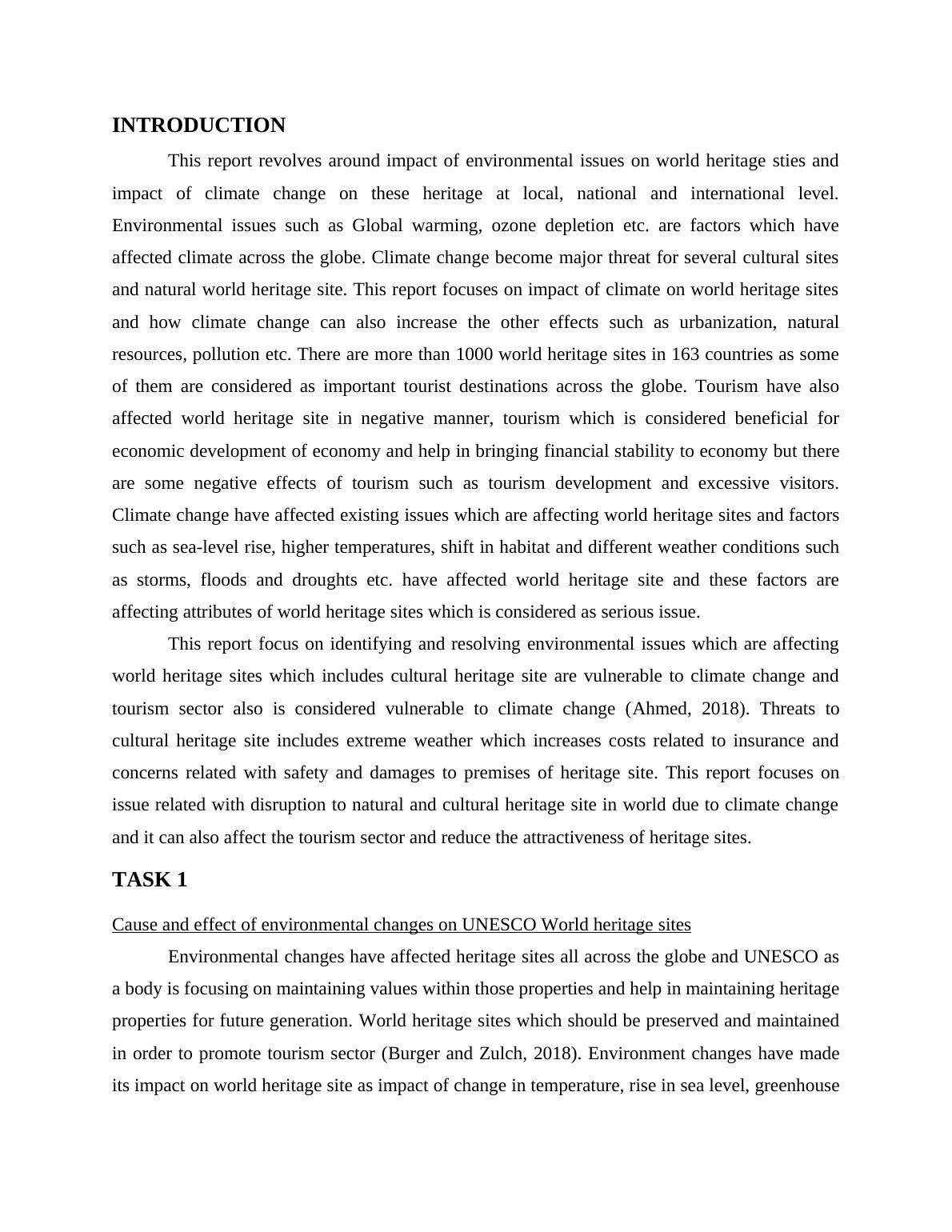
gas emission have made its impact on several world heritage sites. World heritage sites are also
affected by unplanned tourism development and poor management of visitors. Some of the well
known heritage sites in world are Taj Mahal in India, the great Barrier reef in Australia and
Grand Canyon in United States. It has been shown by UNESCO report that many heritage sites
are facing effects of climate change and it have affected the structure of heritage sites. Australia
great barrier reef have faced coral bleaching which occurs due to warmer water which can be
linked with change in temperature at global level. High sea level in Venice have caused damage
to properties in Venice. Heritage sites are considered as important sites due to their uniqueness
and connection to past entities (Callistus and Clinton, 2018).
Heritage help in bringing great amount of revenues for government by encouraging
tourism industry. World heritage sites are considered as one of the valuable tourist destinations
all across the globe and many people livelihood is dependent on their existence as it help in
attracting tourist. UNESCO focuses on developing appropriate plans and strategies which can
help in adopting climate changes and reduce the emission rate in nature. Coral reefs are
considered as example to understand problem of climate change as coral reefs are considered as
world heritage site and most vulnerable to change in environment and other issues related to
climate change. Figures shows that more than half of world reefs are considered at risk of
degradation and it can affect several countries as several countries tourism is associated with
reefs and tourism revenue contributes in GDP of several economies. Reefs in worldwide are
affected by several issue related to environment and climate changes as warm waters and ocean
acidification played vital role in degradation of coral reefs. Coral are important part of marine
environment as its existence is from several million years and temperature change in recent years
have affected adaptability of coral reefs and that's why climate change is considered as threat to
coral reefs (Erdogan, Šaparauskas and Turskis, 2019). Climate change have made its impact on
world heritage sites and it also exacerbate other issues such as lack of management of tourist,
poverty, urbanization etc. Higher temperature helped in influencing changes in environment such
as meting of glaciers, floods and droughts etc.
Protecting world heritage site is considered as priority and it can be possible by
protecting ecosystem. In order to protect world heritage sites focus should be on expanding and
managing buffer zones which help in ensuring connectivity between sites and protected areas.
Monuments, Building and archaeological monuments of cultural world heritage sites and
affected by unplanned tourism development and poor management of visitors. Some of the well
known heritage sites in world are Taj Mahal in India, the great Barrier reef in Australia and
Grand Canyon in United States. It has been shown by UNESCO report that many heritage sites
are facing effects of climate change and it have affected the structure of heritage sites. Australia
great barrier reef have faced coral bleaching which occurs due to warmer water which can be
linked with change in temperature at global level. High sea level in Venice have caused damage
to properties in Venice. Heritage sites are considered as important sites due to their uniqueness
and connection to past entities (Callistus and Clinton, 2018).
Heritage help in bringing great amount of revenues for government by encouraging
tourism industry. World heritage sites are considered as one of the valuable tourist destinations
all across the globe and many people livelihood is dependent on their existence as it help in
attracting tourist. UNESCO focuses on developing appropriate plans and strategies which can
help in adopting climate changes and reduce the emission rate in nature. Coral reefs are
considered as example to understand problem of climate change as coral reefs are considered as
world heritage site and most vulnerable to change in environment and other issues related to
climate change. Figures shows that more than half of world reefs are considered at risk of
degradation and it can affect several countries as several countries tourism is associated with
reefs and tourism revenue contributes in GDP of several economies. Reefs in worldwide are
affected by several issue related to environment and climate changes as warm waters and ocean
acidification played vital role in degradation of coral reefs. Coral are important part of marine
environment as its existence is from several million years and temperature change in recent years
have affected adaptability of coral reefs and that's why climate change is considered as threat to
coral reefs (Erdogan, Šaparauskas and Turskis, 2019). Climate change have made its impact on
world heritage sites and it also exacerbate other issues such as lack of management of tourist,
poverty, urbanization etc. Higher temperature helped in influencing changes in environment such
as meting of glaciers, floods and droughts etc.
Protecting world heritage site is considered as priority and it can be possible by
protecting ecosystem. In order to protect world heritage sites focus should be on expanding and
managing buffer zones which help in ensuring connectivity between sites and protected areas.
Monuments, Building and archaeological monuments of cultural world heritage sites and
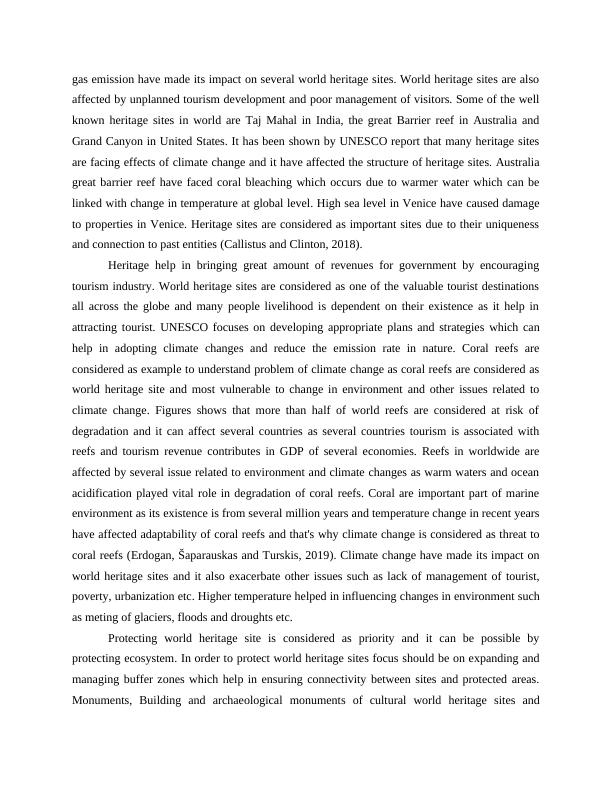
buildings are affected by climate related changes such as damage from extreme wind and heavy
rainfall events as well as coastal erosion, flooding and damp. Building foundation can be
destabilized by increase or decrease in moisture of soil. Climate change does affect temperature
inside buildings as it can cause infestations. Change in temperature and water interaction are
important for architecture as example in this context can be taken about Djenne Mosque in Mali
which is vulnerable to climate change. UNESCO have focused on understanding the cause and
effects on environment and climate change on world heritage sites and UNESCO is focusing on
developing appropriate plan and strategies to tackle these environmental issues. Degradation of
world heritage sites affected tourism sector as it also contributes in GDP of economy.
Environmental factors have made its major impact on several world heritage site in terms of
structure. Climate change have affected cultural and natural world heritage site and it also
affected their sustainability in future (Galagali, 2017).
Intervention and mitigation at local, national and international level
Intervention and mitigation options can help in addressing climate change and its
effective implementation depends on coordination at high scale and implementation of policies
depends on outcomes with achieving other goals and objectives. Innovation and investment help
in bringing change in environment by reducing greenhouse gas emission and it can help in
enhancing resilience to climate change as innovation and change can help in bringing
effectiveness of intervention and mitigation points. Intervention and mitigation at local, national
and international level can help in reducing greenhouse gas emission and environment issues
which are affecting environment in long-term. New technology and infrastructure can help in
reducing effect on natural ecosystem. Intervention and mitigation focuses on innovation and
changes. Example of this can be considered as investment in low carbon and carbon neutral
technology as it can help in reducing intensity of economic development in terms of energy. In
terms of climate change, greenhouse gas emission and capacity of intervention and mitigation is
influenced by livelihood and behaviour.
Energy intensive lifestyle can affect higher energy contribution and high energy
production and GHG emission have increased mitigation costs. Intervention and mitigation is
considered as capacities to adapt and mitigate to manage the climate change risks. These
capacities are considered in context of place and there is no risk reduction is considered
appropriate for all settings (Giao, 2020). Potential implication for mitigation can be explained as
rainfall events as well as coastal erosion, flooding and damp. Building foundation can be
destabilized by increase or decrease in moisture of soil. Climate change does affect temperature
inside buildings as it can cause infestations. Change in temperature and water interaction are
important for architecture as example in this context can be taken about Djenne Mosque in Mali
which is vulnerable to climate change. UNESCO have focused on understanding the cause and
effects on environment and climate change on world heritage sites and UNESCO is focusing on
developing appropriate plan and strategies to tackle these environmental issues. Degradation of
world heritage sites affected tourism sector as it also contributes in GDP of economy.
Environmental factors have made its major impact on several world heritage site in terms of
structure. Climate change have affected cultural and natural world heritage site and it also
affected their sustainability in future (Galagali, 2017).
Intervention and mitigation at local, national and international level
Intervention and mitigation options can help in addressing climate change and its
effective implementation depends on coordination at high scale and implementation of policies
depends on outcomes with achieving other goals and objectives. Innovation and investment help
in bringing change in environment by reducing greenhouse gas emission and it can help in
enhancing resilience to climate change as innovation and change can help in bringing
effectiveness of intervention and mitigation points. Intervention and mitigation at local, national
and international level can help in reducing greenhouse gas emission and environment issues
which are affecting environment in long-term. New technology and infrastructure can help in
reducing effect on natural ecosystem. Intervention and mitigation focuses on innovation and
changes. Example of this can be considered as investment in low carbon and carbon neutral
technology as it can help in reducing intensity of economic development in terms of energy. In
terms of climate change, greenhouse gas emission and capacity of intervention and mitigation is
influenced by livelihood and behaviour.
Energy intensive lifestyle can affect higher energy contribution and high energy
production and GHG emission have increased mitigation costs. Intervention and mitigation is
considered as capacities to adapt and mitigate to manage the climate change risks. These
capacities are considered in context of place and there is no risk reduction is considered
appropriate for all settings (Giao, 2020). Potential implication for mitigation can be explained as
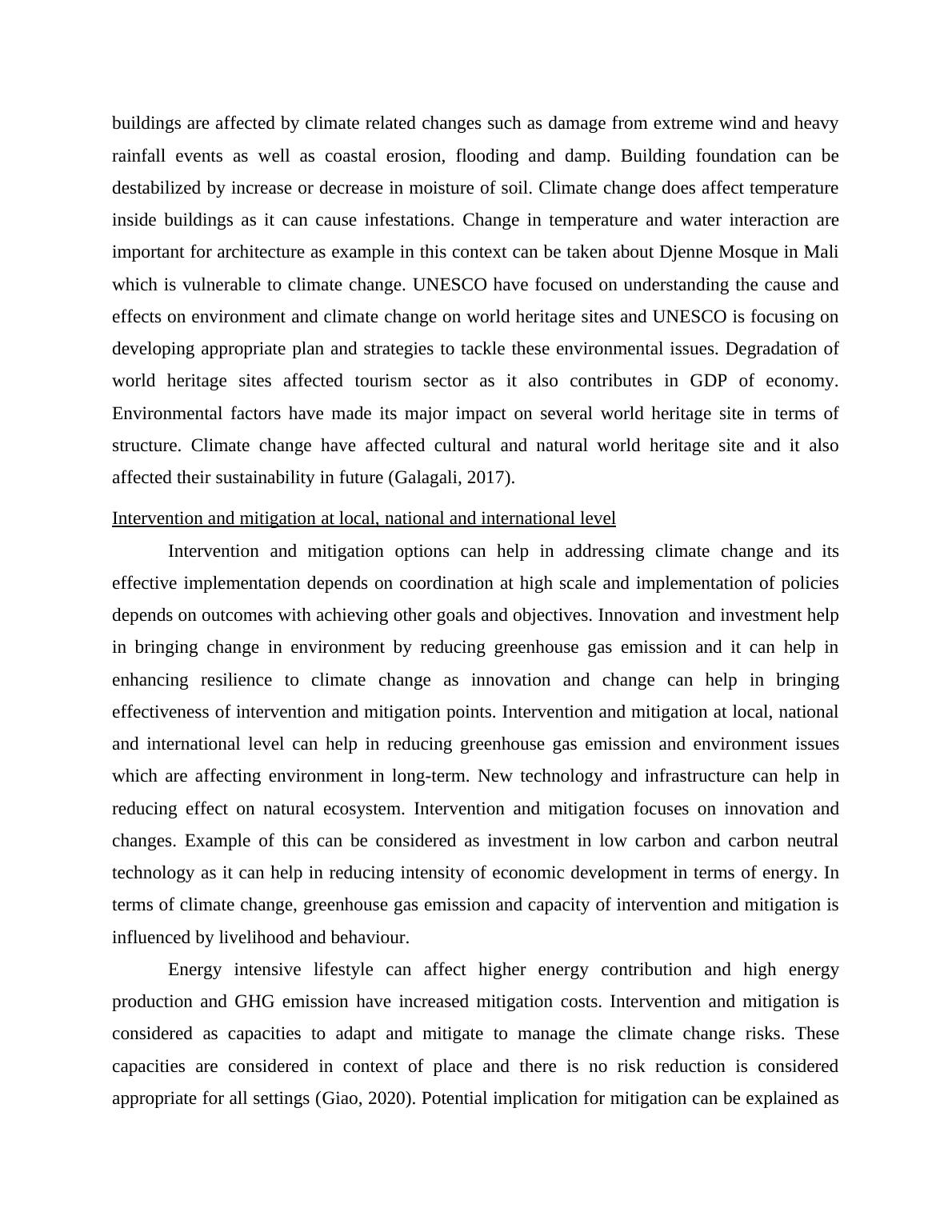
focus on driving economic growth and demand of energy and its consumption which results in
increase in greenhouse gas emissions.
In terms of deficit of knowledge and human capital there are various implications under
mitigation as reducing individual risk perception and to focus on adapting social and
technological innovations which helps in reducing emissions. Another point in implication of
mitigation is related with challenge in governance and institutional agreements which is related
with policies and related with development and incentives and coordination related to
development of policies and implementing effective and efficient carbon-neutral and renewable
energies (Górecki and Bizon-Górecka, 2017). Government and people are now starting to adapt
with climate changes as there are various components included in approaches related to
adaptation planning and disaster risk management. There are points included in this which are
mentioned below:
Social and infrastructure development
Technological process optimization
Effective management of natural resources
Financial services which includes risk transfer
There are several range of options to reduce greenhouse gas emissions as emission can be
reduced in terms of emission intensity and energy intensity can help in bringing efficiency in
terms of resource availability. There is different approaches to mitigation which can help in
bringing benefits in land use sector. Mitigation and Intervention is are two approaches to
minimize the risk of climate change on ecosystem and on humans. It also focuses on reducing
the greenhouse gas emissions and greenhouse gas emission sinks, several approaches is needed
to avoid negative impacts of such issues. Developing countries are facing heavy challenges of
climate change and GHG emissions (Ha and Tran, 2017).
Appropriate reference to protocols, International agreements, organisations documents and
relevant legislation and its application to the World Heritage Site under investigation.
There are several protocols and agreements made by countries with help of UNESCO
which focuses on conserving cultural and natural world heritage sites by implementing effective
change in ecosystem. Implementation of world heritage convention is also part of this as there
are operational guidelines for implementation of world heritage convention and in order to
increase in greenhouse gas emissions.
In terms of deficit of knowledge and human capital there are various implications under
mitigation as reducing individual risk perception and to focus on adapting social and
technological innovations which helps in reducing emissions. Another point in implication of
mitigation is related with challenge in governance and institutional agreements which is related
with policies and related with development and incentives and coordination related to
development of policies and implementing effective and efficient carbon-neutral and renewable
energies (Górecki and Bizon-Górecka, 2017). Government and people are now starting to adapt
with climate changes as there are various components included in approaches related to
adaptation planning and disaster risk management. There are points included in this which are
mentioned below:
Social and infrastructure development
Technological process optimization
Effective management of natural resources
Financial services which includes risk transfer
There are several range of options to reduce greenhouse gas emissions as emission can be
reduced in terms of emission intensity and energy intensity can help in bringing efficiency in
terms of resource availability. There is different approaches to mitigation which can help in
bringing benefits in land use sector. Mitigation and Intervention is are two approaches to
minimize the risk of climate change on ecosystem and on humans. It also focuses on reducing
the greenhouse gas emissions and greenhouse gas emission sinks, several approaches is needed
to avoid negative impacts of such issues. Developing countries are facing heavy challenges of
climate change and GHG emissions (Ha and Tran, 2017).
Appropriate reference to protocols, International agreements, organisations documents and
relevant legislation and its application to the World Heritage Site under investigation.
There are several protocols and agreements made by countries with help of UNESCO
which focuses on conserving cultural and natural world heritage sites by implementing effective
change in ecosystem. Implementation of world heritage convention is also part of this as there
are operational guidelines for implementation of world heritage convention and in order to
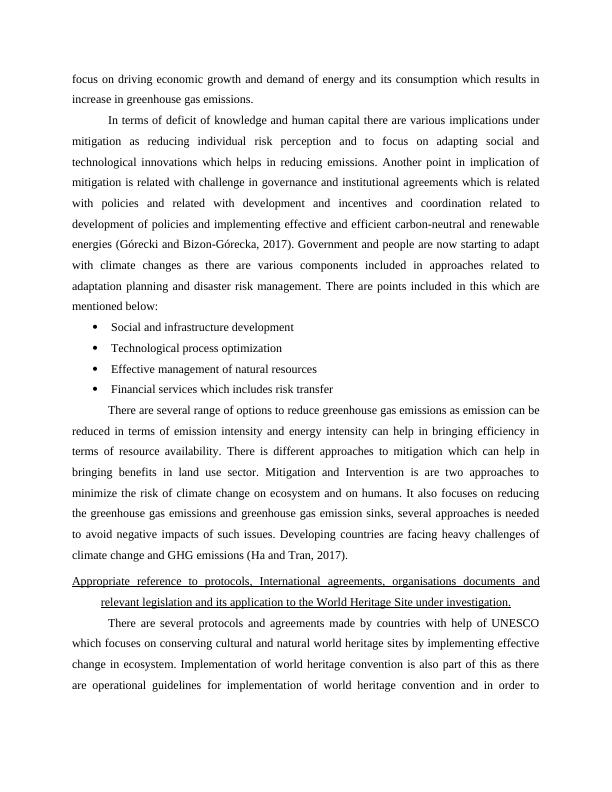
End of preview
Want to access all the pages? Upload your documents or become a member.
Related Documents
Impact of Environmental Changes on UNESCO World Heritage Siteslg...
|20
|7111
|73
World Heritage at Risk & Sustainable Constructionlg...
|14
|4324
|15
World Heritage Sites: Importance, Nomination Process, and Recommendations for Preservationlg...
|7
|1830
|261
Preservation of World Heritage Sites in the Modern Worldlg...
|13
|4412
|123
Unit 9: Tourist Destination Task 2 Understand the cultural,lg...
|5
|273
|217
Emerging Issues In Hospitality And Tourism docx.lg...
|8
|2064
|29
